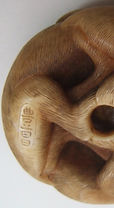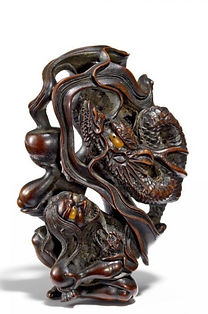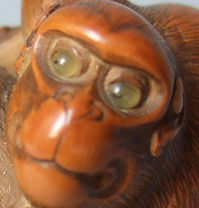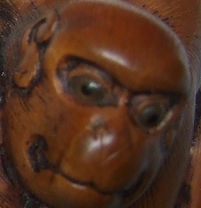



Les faux Toyomasa
Il est très facile de voir si une pièce est un faux quand l’artiste est un gaucher et que le faussaire est droitier. Car il y a un choix d’orientation du sujet qu’il tient de la main droite et la position est impacté par la position des mains ; le sculpteur va positionner la tête de façon à l’avoir face à lui de façon que le sujet s’adresse à lui, car suivant le sujet il ne s’enroule pas dans le même sens. On reconnaît aussi le geste du droitier ou du gaucher dans l’attaque du matériau et l’orientation des poils.
Toyomasa père n’a jamais travailler que le bois, ses lettres à Mitsuhiro en sont le témoignage. Son fils lui était gaucher et a signé plusieurs fois Hidari Toyomasa. Hidari voulant dire gaucher, contrairement à son père il fit quelque netsuke en ivoire mais le netsuke que nous avons ici fut sculpté par un droitier Sur la partie supérieure droite, on voit le travail croisé des écailles. La partie droite de ce travail, vers le relief du nuage, est moins finie, on sent que le relief gêne le sculpteur. De même, la partie entre la tête et le bras est plus travaillée sur la gauche que sur la droite. Pareil pour la partie droite des écailles qui est moins travaillée, notamment dans le creux entre la corne et l'oreille.
Le sculpteur a négligé ce qui le gênait naturellement. Les petits traits rapides sur le bras et la jambe, c'est typiquement le type de traits que fait un droitier qui est à l’opposé de ce que ferait un gaucher par la façon de tenir l’outil, les arcs de cercle ronds vers l’extérieur. Quand on regarde cette sculpture, elle est très raide, le dessin des nuages masque l’attache de la patte et ce dessin est raide, très stéréotypé les deux moustaches du dragon sont étrangement symétriques. La bouche du dragon est incurvée sans aucun mouvement et à la signature qui est visiblement pas de la main de Toyomasa et le faussaire a cru intelligent de rajouter 丹州 (Tanshu /Tanba)
Nous avons aussi vu, de dos ,un faux du même sujet et d'un traitement different dont le faussaire n'a pas cherché à patiné l'ivoire et dont on voit le dos avec toutes ses imperfections ci-contre.
Il y a de nombreux faux Toyomasa en ivoire fait récemment depuis que cet artiste fait de gros prix ,certains sont très facile à déceler par la grossièreté de la sculpture et le manque total de similitude avec le sujet comme ce manju sculpté de trois singes avec les incrustations des yeux qui n’ont rien à voir avec ce que les Toyomasa ont fait, même le traitement de la tête et des oreilles n’a rien à voir avec le travail des Toyomasa et je ne parle même pas des mains.......
d'ailleurs seul le fils qui était gaucher à travaillé l'ivoire et ce n'est pas le travail d'un gaucher.
Toyomasa Fakes
It is very easy to see if a piece is a fake when the artist was left handed and the carver making the fake right handed, let us study this ivory carving made by a right handed man knowing that the carver he is copying was left handed.
We know from letters that he wrote to Mitsuhiro that the first Toyomasa, the father, never carved in ivory . Latter his son did sometime but he was left handed and this carving was made by a right handed man. The position of the subject is impacted by the position of the hands of the carver, since when you carve the hand hides a part of the subject, it does not coil in the same direction and the artist want to have the head that looks at him. The left-hand carver and the right-handed one attack the subject in a different way. For intense when he makes the eyes he carves the corner of the eye by pulling it to the right but this is difficult to see just as they do not scrape the ivory in the same way from left to right and from right to left but that is difficult to see for someone who never tried to carve.
Look at this carving on the upper right, we see the cross work of the scales. The right part of this work, towards the relief of the clouds, is less finished, the relief embarrasses the carver. Similarly, the part between the head and the arm is more worked on the left than on the right, the right part of the scales is less worked, especially in the hollow between the horn and the ear. The carver is making his stoke quickly pulling the tool towards him he neglected what naturally bothered him. The quick strokes on the arm and leg is typically the type of strokes a right handed man makes. The curves of a left handed man would be the other way round.
On top of the signature is written Tanshu the character for Shu is always used for a place which here would be Tanba but none of theToyomasa used this name which is useless here. When you look at the carving it is very stiff and the cloud design try to hide how the leg would fit and the shape of the clouds are stiff and very stereotyped, the two whiskers are strangely diametric. The mouth of the dragon is just a curve without any mouvement and at its corner it is very different from any other dragon the master did. The denty spine as well and the inlaid eye is not taken from the tortoise shell end of shell. The carving of the man is slightly better. The use of electric tools which is easy to see since that they bruise the wood and chew up fibrers on a micro level, making a fine polish difficult but on ivory it is different..
There are numerous fakes in ivory with a Toyomasa signature made recently since this artist made big prizes but they are are very easy to recognise by the rudeness of the carving and the total lack of similarity with the treatment of the subject by the master as this manju of the three wise monkeys with red inlaid eyes which have nothing to do with what Toyomasa made, even the treatment of the head and the ears has nothing to do with the work of Toyomasa and I am not talking about the hands...
gue du Musée asiatique
Titre 1



faux - fakesfa



Genuine Toyomasa - Authentique Toyomasa ci-dessous





